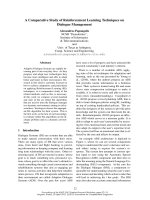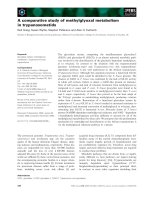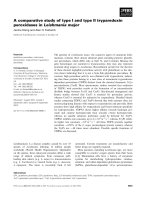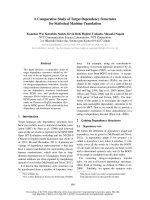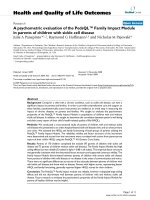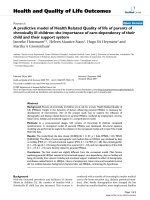báo cáo hóa học:" A Comparative Study of HIV/AIDS: The Knowledge, Attitudes, and Risk Behaviors of Schizophrenic and Diabetic Patients in Regard to HIV/AIDS in Nigeria" doc
Bạn đang xem bản rút gọn của tài liệu. Xem và tải ngay bản đầy đủ của tài liệu tại đây (203.33 KB, 6 trang )
BioMed Central
Page 1 of 6
(page number not for citation purposes)
Journal of the International AIDS Society
Open Access
Research article
A Comparative Study of HIV/AIDS: The Knowledge, Attitudes, and
Risk Behaviors of Schizophrenic and Diabetic Patients in Regard to
HIV/AIDS in Nigeria
Olawale O Ogunsemi*
1
, Rahmaan A Lawal
2
, Gbenga T Okulate
3
,
Christopher O Alebiosu
1
and Michael O Olatawura
1
Address:
1
Olabisi Onabanjo University Teaching Hospital, Sagamu, Ogun State, Nigeria,
2
Psychiatric Hospital Yaba, Lagos State, Nigeria and
3
Nigerian Army Reference Hospital, Yaba, Lagos State, Nigeria
Email: Olawale O Ogunsemi* -
* Corresponding author
Abstract
Context: Studies on knowledge and risk behaviors related to HIV/AIDS reported from developed
countries have shown that people with psychiatric disorders constitute a special risk group. In
Nigeria, although similar studies have been conducted on various population groups, there has, so
far, been no reported study on people suffering from psychiatric disorders.
Objective: The present study set out to compare knowledge, attitudes, and risk behaviors related
to HIV/AIDS among schizophrenic patients and diabetic patients.
Methods: Ninety-eight consecutive schizophrenic patients attending the outpatient clinics of a
psychiatric hospital over a period of 8 weeks completed an interviewer's administered
questionnaire. The interview covered demographics, risk behaviors, knowledge related to HIV/
AIDS, and patients' attitudes toward people infected with HIV/AIDS. Their responses were
compared with those of 56 diabetic patients who were similarly interviewed in a teaching hospital.
Results: Compared with the diabetic patients, the schizophrenic patients were significantly less
sexually active in the previous 12 months (P < .05). They had more misconceptions about HIV/AIDS
and were less tolerant towards people living with HIV/AIDS compared with the diabetic patients.
They were also more likely to engage in high-risk behaviors.
Conclusion: Mental health providers rarely educate psychiatric patients about HIV/AIDS and
should be more involved in doing so. Despite being less sexually active, patients with schizophrenia
engaged in risk behaviors as did the diabetic patients.
Introduction
Since the first clinical case of acquired immune deficiency
syndrome (AIDS) was reported more than 2 decades ago,
the syndrome has acquired the potential for being the
most devastating disease that humankind has ever faced,
with about 40.3 million people living with the virus and
3.1 million AIDS deaths in 2005.[1] The spread of HIV
infection has engaged the attention of researchers all over
the world. Apart from studies directed at studying the
characteristics of the virus to facilitate discovery of potent
vaccines, research efforts have also been geared towards
containing the spread of the infection. Efforts were also
directed towards the assessment of the knowledge and
attitude of individuals and groups of people towards
Published: 29 November 2006
Journal of the International AIDS Society 2006, 8:42
This article is available from: />Journal of the International AIDS Society 2006, 8:42 />Page 2 of 6
(page number not for citation purposes)
those with HIV infection.[2] This is particularly important
in developing countries, especially sub-Saharan Africa,
which carries the greatest burden of HIV infection and
where large-scale ignorance about the cause and preven-
tion of the disease prevails.
Several studies have reported the knowledge, attitude, and
behavior of identified groups at high risk for HIV infec-
tion.[3,4] Little attention, however, has been paid to psy-
chiatric patients as a vulnerable and disadvantaged group
with a high risk for HIV infection.[5,6] Recent literature
has demonstrated that psychiatric patients, particularly
those with a diagnosis of schizophrenia, may be at high
risk for HIV infection.[7] HIV risk behaviors, such as shar-
ing of needles by drug addicts, unprotected sex, and oth-
ers, have also been reported in a substantial proportion of
mentally ill patients, particularly patients with bipolar
disorders and schizophrenia.[6,8,9]
Although a considerable body of research on HIV/AIDS
especially on knowledge, attitude, and risk behaviors in
various groups has been reported in Nigeria,[4,10,11]
reports of studies on knowledge, attitudes, and risk behav-
iors, in particular, are rather scanty on HIV/AIDS among
psychiatric patients in the country.
Study Objectives
The present study was designed to compare the HIV/AIDS
knowledge, attitudes, and risk behaviors of schizophrenic
patients with those of diabetic patients.
Specific objectives:
• To determine the knowledge, attitudes, and risk
behaviors of schizophrenic patients in regard to HIV/
AIDS;
• To determine the knowledge, attitudes, and risk
behaviors of diabetic patients in regard to HIV/AIDS;
and
• To compare these 2 groups on these parameters and
make conclusions as to how best to improve the
knowledge, attitude, and risk behaviors of schizo-
phrenic patients in regard to HIV/AIDS.
Methods
Subjects
Ninety-eight consecutive and consenting patients aged
1950 years who reported at the outpatient clinic of Psychi-
atric Hospital, Yaba, and who satisfied the International
Classification of Disease (ICD-10) diagnostic criteria for
schizophrenia were recruited into the study over a period
of 8 weeks. The patients had become clinically stable fol-
lowing treatment for not less than 1 year. Those who were
unable to provide meaningful responses because of their
psychosis were excluded.
Over the same period of time, a total of 69 consecutive
and consenting attendees of the outpatient endocrinology
clinic of the Lagos State University Teaching Hospital,
Ikeja, suffering from diabetes mellitus were initially
recruited. The diabetic patients were screened with Gen-
eral Health Questionnaire version 28 (GHQ-28) for the
assessment of psychiatric morbidity. GHQ has been previ-
ously used as a screening instrument for psychiatric mor-
bidity and validated in a number of studies in
Nigeria.[12,13] Fifty-six of the subjects whose scores indi-
cated no psychiatric morbidity were included in the study.
This group only included those who were within the age
range of 1950 years. The diabetic patients were chosen as
the comparison group because diabetes mellitus, like
schizophrenia, runs a chronic course and requires special-
ist attention.
Assessment
A modified version of the instrument used for the
National HIV/AIDS and Reproductive Health Survey
(NARHS) in Nigeria[14] was used to assess the subjects'
knowledge of HIV/AIDS and their attitude and behavior
toward persons with the disease. The instrument included
sections on background characteristics, sexual behaviors,
and condom use.
Data Analyses
The data were analyzed using the Statistical Package for
Social Sciences (SPSS), version 10.[15] All statistical tests
were at 5% probability level (P < .05).
Results
Sociodemographic Characteristics of Subjects
The age range for both groups of patients was 1950 years
(Table 1 ). The mean age of the schizophrenic patients was
34.46 ± 7.70 years, while the mean age of the diabetic
patients was 39.59 ± 7.69 years. Fifty-five (56.1%) of the
schizophrenic patients were males compared with 30
(53.6%) of the diabetic patients (P = .759). Forty-two
(75%) of the diabetic patients were married compared
with 17 (17.3%) of the schizophrenic patients (P < .001).
Only 20 (20.4%) of the schizophrenic patients were able
to attain tertiary education (university education) com-
pared with 17 (30.4%) of the diabetic patients (P = .164).
Compared with the diabetic patients (12.5%), more
schizophrenic patients (46.9%) were unemployed (P <
.001) . More schizophrenic patients (20.4%) were artisans
compared with the diabetic subjects (5.4%) (P = .012).
Psychoactive Substance Use by Subjects
Psychoactive substance use by the patients of the 2 groups
was generally low. However, more of the schizophrenic
Journal of the International AIDS Society 2006, 8:42 />Page 3 of 6
(page number not for citation purposes)
Table 1: Demographic Characteristics of Subjects
Variables Schizophrenia n (%) Diabetes n (%) Statistical Significance (P Value)
Sex
Male 55 (56.1) 30 (53.6) P = .759
Female 43 (43.9) 26 (46.4)
Age (years)
< 21 1 (1.0) 1 (1.8)
21 30 37 (37.8) 7 (12.5)
31 40 36 (36.7) 21 (37.5)
41 50 25 (24.5) 27 (48.2)
Employment
Unemployed 46 (46.9) 7 (12.5) P < .001
Employed 52 (53.1) 49 (87.5)
Marital status
Married 17 (17.3) 44 (78.6) P < .001
Not married 81 (82.7) 12 (21.4)
Level of education
Nil 4 (4.1) 4 (7.1)
Primary 22 (22.4) 15 (26.8)
Secondary 52 (53.1) 20 (35.7)
Tertiary 20 (20.4) 17 (30.4)
Religion
Christianity 72 (73.5) 50 (89.3)
Islam 24 (26.5) 5 (8.9)
Other 1 (1.8)
Table 2: Sexual Behavior of Subjects
Sexual Behavior of Subjects Schizophrenia n (%) Diabetes n (%) Statistical Significance (P Value)
Have had sexual intercourse 82 (83.7) 52 (92.9) P = .103
Sexually active in the last 12 months 35 (42.7) 41 (78.8) P < .001
Had used condom 41 (50.0) 30 (57.7) P = .186
Had sex without condom with nonmarital sex partner in the
last 12 months
12 (34.3) 8 (19.5) P = .145
Sexual intercourse with same sex 0 0
Journal of the International AIDS Society 2006, 8:42 />Page 4 of 6
(page number not for citation purposes)
patients (8.2%) compared with none (0%) of the diabetic
patients had used cannabis (P = .030). On the other hand,
the diabetic patients used alcohol more than the schizo-
phrenic patients (diabetes 23.2%; schizophrenia 10.2%)
in the 4 weeks (current use) prior to the interview (P =
.029). The level of usage was not considered in the ques-
tionnaire. None of the patients in the 2 groups had ever
used cocaine or heroin. None of the patients was injecting
psychoactive substance.
Sexual Behavior of Subjects
The majority of the patients in the 2 groups had had sex-
ual intercourse (schizophrenia 83.7%; diabetes 92.9%)
(Table 2 ). Significantly more of the diabetic patients
(78.8%) had had sexual intercourse in the previous 12
months before the study compared with the schizo-
phrenic patients (42.7%) (P < .001).
Despite the generally high level of awareness about the
use of condoms in the 2 groups (schizophrenia 89%; dia-
betes 92.9%), only 50% of the schizophrenic and 57.7%
of the diabetic patients had ever used condoms. During
the previous 12 months, proportionally more of the sexu-
ally active schizophrenic patients (34.3%) did not use
condoms during sexual intercourse with sexual partners to
whom they were not married. This compares with 19.5%
of diabetic patients (Table 2 ). None of the male patients
reported having sex with men.
Subjects' Knowledge of HIV/AIDS
Almost all of the patients in the 2 groups (schizophrenia
95.9%; diabetes 100%) were aware of the existence of
HIV/AIDS. Their main source of information was elec-
tronic media (radio and television). The proportion of
healthcare providers/institutions as a source of informa-
tion was small in the 2 groups of patients (schizophrenia
1.1%; diabetes 1.8%).
The knowledge of the 2 groups of subjects varied for dif-
ferent subject areas (Table 3 ). Sixty-four (65.3%) of the
schizophrenic patients and 40 (71.4%) of the diabetic
patients knew that people could protect themselves from
HIV infection by using condoms correctly every time they
have sex (P = .435). The 2 groups showed high knowledge
about the protective effect of having 1 uninfected faithful
partner (schizophrenia 79.6%; diabetes 85.7%) (P =
.343), abstaining from sex (schizophrenia 83.7%; diabe-
tes 85.7%) (P = .737) and risk of intravenous transmis-
sion from using unsterilized or previously used needles
and sharp objects (schizophrenia 82.7%; diabetes 96.4%)
(P = .012). Compared with the schizophrenic patients, a
higher proportion of diabetic patients knew that HIV
could be transmitted through breastfeeding (schizophre-
nia 53.1%; diabetes 64.3%) (P = .176) and from a mother
to an unborn baby (schizophrenia 61.2%; diabetes
76.8%) (P = .048).
Misconceptions About HIV/AIDS
The percentage of misconceptions about HIV/AIDS was
higher among the schizophrenic patients compared with
the diabetic patients. Twenty-one (21.4%) of the schizo-
phrenic and 6 (10.7%) of the diabetic patients believed
that one could become infected with HIV by sharing a
meal with an infected person (P = .093). Twenty-three
(23.5%) of the schizophrenic and 9 (16.1%) of the dia-
betic patients believed that people could be infected with
HIV through mosquito bites (P = .276).
Table 3: Knowledge of Subjects About HIV/AIDS
Area of Knowledge Schizophrenia n (%) Diabetes n (%) Statistical Significance (P Value)
Correct use of condom is protective 64 (65.3) 40 (71.4) P = .435
Can get HIV from mosquito bites 23 (23.5) 9 (16.1) P = .276
Having one uninfected faithful partner is safe 78 (79.6) 48 (85.7) P = .343
Abstaining from sex is protective 82 (83.7) 48 (85.7) P = .737
Can get HIV by sharing meals 21 (21.4) 6 (10.7) P = .093
Can get HIV through sharing sharp objects 81 (82.7) 54 (96.4) P = .012
Healthy-looking person can have HIV 68 (69.4) 45 (80.4) P = .138
Mother can transmit HIV to unborn baby 60 (61.2) 43 (76.8) P = .048
Can get HIV through breastfeeding 52 (53.1) 36 (64.3) P = .176
Journal of the International AIDS Society 2006, 8:42 />Page 5 of 6
(page number not for citation purposes)
Attitude of Subjects Towards People Infected With HIV/
AIDS
The attitude of the 2 groups of patients differed consider-
ably towards people infected with HIV/AIDS (Table 4 ).
Compared with diabetic patients, a higher proportion of
schizophrenic patients would not eat with HIV/AIDS-
infected persons (schizophrenia 22.4%; diabetes 42.9%)
(P = .008) or tolerate the care of infected relatives in their
households (schizophrenia 39.8%; diabetes 67.9%) (P =
.001). However, the 2 groups were similar in terms of
wanting the diagnosis to remain secret. should a family
member become infected with HIV (schizophrenia
65.3%; diabetes 67.9%) (P = .747).
Discussion
This study demonstrated that a group of schizophrenic
patients were less knowledgeable about HIV/AIDS than a
group of diabetic patients. However, awareness about the
existence of HIV/AIDS by both the schizophrenic and dia-
betic subjects was generally good. This finding is in line
with the general trend in other parts of the world.[10,16]
A similarly high level of awareness has also been reported
in a national HIV/AIDS and reproductive health survey in
Nigeria.[14] It is noteworthy that both groups of subjects
reported contact with HIV/AIDS prevention programs,
mostly through radio and television. The important role
of mass media, especially radio and television, in the dis-
semination of information to the citizenry of Nigeria has
been reported previously.[11,14] The present study fur-
ther strengthened the evidence that the mass media is
making the desired impact with regard to information
about HIV/AIDS in Nigeria.
The impact of healthcare providers/institutions in the dis-
semination of information on HIV/AIDS issues was rather
poor, however. This finding, which was consistent with a
report by Ayankogbe and colleagues,[11] is somewhat dis-
turbing as it leaves much to be desired from healthcare
providers/institutions as a veritable source of information
as far as HIV/AIDS prevention is concerned. This could
mean that healthcare providers outside of HIV/AIDS clin-
ics do not routinely counsel patients about HIV/AIDS.
There is, therefore, the need for healthcare providers, espe-
cially of mental health institutions, to be actively involved
in educating their patients about HIV/AIDS. Despite the
good level of awareness about the existence of HIV/AIDS
by the 2 groups, the schizophrenic patients were less
knowledgeable on issues concerning HIV/AIDS. This
could be responsible for their attitude towards people liv-
ing with HIV/AIDS.
This study also showed that the schizophrenic patients
had more misconceptions about the route of transmission
of HIV infection than the comparator group. These mis-
conceptions may be responsible for the attitude of the
schizophrenic subjects towards people living with HIV/
AIDS; they were less tolerant and less accommodating
towards people living with HIV/AIDS than the diabetic
patients. Stigma and discrimination shown to these peo-
ple can worsen the spread and impact of the HIV/AIDS
epidemic because people will be less inclined to go for
screening voluntarily or acknowledging their HIV status. It
was not surprising, therefore, that the majority of the
patients said that they would maintain secrecy should any
of their family members become HIV-positive.
The schizophrenic patients were reported to be less sexu-
ally active in the previous 12 months than were the dia-
betic patients. The finding that most of the schizophrenic
patients in this study were not married could be responsi-
ble for this. Studies have shown that apart from the diffi-
culty in establishing psychosocial relationships due to
stigma attached to schizophrenic illness,[17] the side
effects of their antipsychotic medications can affect their
sexual functions.[18]
Table 4: Attitude of Subjects Towards Person With HIV/AIDS
Area of Belief Schizophrenia n (%) Diabetes n (%) Statistical Significance (P Value)
Can eat with person with HIV/AIDS 22 (22.4) 24 (42.9) P = .008
Can care for male relative with HIV/AIDS 39 (39.8) 38 (67.9) P = .001
HIV-infected student should continue schooling 49 (50.0) 36 (64.3) P = .086
Can care for female relative with HIV/AIDS 39 (39.8) 37 (66.1) P = .002
HIV-infected teacher should continue teaching 45 (45.9) 36 (64.3) P = .028
Can buy food from a shopkeeper with HIV 9 (9.2) 33 (58.9) P < .001
Secrecy about an infected family member 64 (65.3) 38 (67.9) P = .747
Journal of the International AIDS Society 2006, 8:42 />Page 6 of 6
(page number not for citation purposes)
Among the sexual risk behaviors is the neglect of protec-
tion offered with the use of condoms, seen in both groups.
However, the schizophrenic patients were more likely to
engage in sexual intercourse without condoms with sexual
partners to whom they were not married (although this
difference was not statistically significant). This risky
behavior could facilitate infection with HIV and other sex-
ually transmitted diseases. Studies on condom use by the
mentally ill in other countries were inconsistent about
this. McKinnon and coworkers[19] in New York reported
that condoms were not used in 58.1% of their cohort of
mentally ill, while Grassil and colleagues[8] in Italy found
that 41% of their schizophrenic patients did not use con-
doms.
It is worth mentioning that other risk groups, such as men
who have sex with men and those who use intravenous
psychoactive substances, reported in psychiatric patients
in the developed countries, were uncommon in this study.
This study has shown that mental health providers rarely
educate psychiatric patients about HIV/AIDS and should
be more involved in doing so. Nonetheless, media cam-
paigns directed to the general public appear to be reaching
people with schizophrenia as well. Although patients with
schizophrenia were significantly less sexually active than
the diabetic patients, they nonetheless had the same level
of sexual risk behavior. This can be seen by the fact that
they had somewhat higher rates of having sex without a
condom with a nonmarital sex partner in the last 12
months compared with the diabetic patients, although
this difference did not reach statistical significance. These
findings are consistent with other studies in the United
States and elsewhere which showed that although people
with severe mental illness were less sexually active than
the general population,[5,8,20] the sexual activity that
they were engaged in puts them at the same or greater
level of risk for HIV as the general population.
In conclusion, this study has shown that special risk
groups, such as persons with schizophrenia, need targeted
enlightenment and counseling by public health workers
while waiting to be attended to at outpatient clinics.
Authors and Disclosures
Dr. Olawale O. Ogunsemi, MB, ChB, FMCPsych, has dis-
closed no relevant financial relationships.
Dr. Rahmaan A. Lawal, MBBS, FMCPsych, MPH, has dis-
closed no relevant financial relationships.
Dr. Gbenga T. Okulate, MB, ChB, FMCPsych, FWACP, has
disclosed no relevant financial relationships.
Dr. Christopher O. Alebiosu, BSc, MB, ChB, FWACP, has
disclosed no relevant financial relationships.
Prof. Michael O. Olatawura, MBBS, DPM, FMCPsych,
FWACP, FRCPsych, has disclosed no relevant financial
relationships.
References
1. United Nations Programme on HIV/AIDS and World Health Organi-
zation: AIDS epidemic update. 2005 [www.unaids.org/epi/2005
].
Acessed October 18 2006
2. Ralston GE, Dow MG, Rothwell B: Knowledge of AIDS and HIV
among various groups. Br J Addict 1992, 87:1663-1668. Abstract
3. Morio S, Soda K, Tajima K, et al.: Sexual behaviour of commercial
sex workers and their clients in Cambodia. Japan-Cambodia
Collaborating Research Group. J Epidemiol 1999, 9:175-182.
Abstract
4. Odujinrin MT, Adebajo SB: Social characteristics, HIV/AIDS
knowledge, preventive practices and risk factors elicitation
among prisoners in Lagos, Nigeria. West Afr J Med 2001,
20:191-198. Abstract
5. Katz RC, Watts C, Santman J: AIDS knowledge and high risk
behaviours in the chronic mentally ill. Community Ment Health J
1994, 30:395-402. Abstract
6. Grassil L: Risk of HIV infection in psychiatrically ill patients.
AIDS Care 1996, 8:103-116. Abstract
7. Grassil L, Biancosino B, Righi R, et al.: Knowledge about HIV
transmission and prevention among Italian patients with
psychiatric disorders. Psychiatr Serv 2001, 52:679-681. Abstract
8. Grassil L, Pavanati M, Cardelli R, et al.: HIV-risk behaviour and
knowledge about HIV/AIDS among patients with schizo-
phrenia. Psychol Med 1999, 29:171-179. Abstract
9. Otto-Salaj LL, Stevenson LY: Influence of psychiatric diagnoses
and symptoms on HIV risk behaviour in adults with serious
mental illness. AIDS Read 2001, 11:197-204. 206208
10. Harding AK, Anadu EC, Gray LA, et al.: Nigerian university stu-
dents' knowledge, perception, and behaviours about HIV/
AIDS: are these students at risk? J R Social Health 1999,
119:23-31.
11. Ayankogbe OO, Omotola BD, Inem OA, et al.: Knowledge, atti-
tudes, beliefs and behavioural practices for creating aware-
ness about HIV/AIDS in Lagos State, Nigeria. Niger Med Pract
2003, 44:7-10.
12. Gureje O, Obikoya B: The GHQ-12 as a screening tool in pri-
mary health care setting. Soc Psychiatry Psychiatr Epidemiol 1990,
25:276-280. Abstract
13. Aderibigbe YA, Gureje O, Omigbodun O: Postnatal emotional
disorders in Nigerian women. A study of antecedents and
association. Br J Psychiatry 1993, 163:645-650. Abstract
14. Federal Ministry of Health: National HIV/AIDS and reproductive
health survey. Abuja, Nigeria 2003.
15. SPSS: SPSS for Windows, version 10. Chicago, Ill: SPSS Inc; 1998.
16. Eriksson T, Sonesson A, Isacsson A: HIV/AIDS information and
knowledge: a comparative study of Kenyan and Swedish
teenagers. Scand J Soc Med 1997, 25:111-118. Abstract
17. Horwath E, Cournos F: Schizophrenia and other psychotic dis-
orders. In Psychiatry Edited by: Cutler JL, Marcus ER. Philadelphia:
W.B. Saunders; 1999:64-80.
18. Buffum J: Pharmacosexology: the effects of drugs on sexual
function, a review. J Psychoactive Drugs 1982, 14:5-44. Abstract
19. McKinnon K, Cournos F, Sugden R, et al.: The relative contribu-
tion of psychiatric symptoms and AIDS knowledge to HIV
risk behaviours among people with severe mental illness. J
Clin Psychiatry 1996, 57:506-513. Abstract
20. Kelly JA, Murphy DA, Bahr GR, et al.: AIDS/HIV risk behaviour
among the chronic mentally ill. Am J Psychiatry 1992,
149:886-889. Abstract


